[vc_row el_position=”first”] [vc_column] [vc_column_text el_position=”first last”]
By Christopher K. Travis
(Copyright 2002 – All rights reserved)

These questions seem frivolous on the surface, but after twenty-five years of helping people design, build and remodel their homes, I’ve become convinced that understanding the “emotional architecture” a client brings to a project is a critical part of designing a house that feels like a “home.”
In the architecture firm with which I am associated, we are trying to develop a technology that tailors our projects to the true natures of our clients, but it’s not easy.The issue of “home” is a highly emotional one. Logic seldom comes into it.
The fact is, when most people decided to remodel their home or build a new house…they lose their minds!
It’s true. Stable marriages topple like palm trees in the hurricane of home improvement. Pleasant, cooperative homemakers turn into Machiavellian harpies, combating husbands who vow to fight to the death on the ramparts of their own financial Alamos.
Practical, down-to-earth CPA’s suddenly realize they are the reincarnation of Frank Lloyd Wright. Customers lie about their budgets, trying to bargain with the designer as though they were buying their house from a Tijuana sombrero salesman.
Perfectly reasonable people, who would never dream of telling their doctor how to treat a disease or their lawyer how to draft their will, think nothing of telling a professional architect how to design their home.
Worst of all, when people begin the process of designing a new home, they forget the basic laws of economics. I long ago discovered that when customers who were over budget came to my office to “trim the fat,” they were actually going to add a Jacuzzi, upgrade the ceramic tile, change the plastic laminate counter tops to granite, and then expect the price to drop.
It set me to wondering.One day I experienced an epiphany. I was converting a group of historic buildings in Round Top into a country inn.
The Queen and my kids were still in Houston. Every Monday morning I drove up to Round Top and then drove home to Houston every Friday night. In between, I slept on an air mattress on the second floor of an old pier and beam house, one of several we were restoring.

I remembered a place from my childhood…, my great grandfather’s porch. I called him “Nandaddy.” I can still see him dressed in overalls, bending down to pick me up, a broad smile on his face. “Come hug my neck,” he would say.
When I was a young child, I spent a lot of time on my great-grandfather’s porch. I cannot remember a time in my life when I felt more loved or appreciated. He and my great-grandmother lived in a pier and beam farmhouse in Milam County, Texas. It had a wood plank porch which wrapped around three sides.
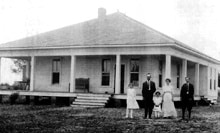
Suddenly I understood why I kept returning to historic restoration work even though, truth be told, it was less profitable than my other building ventures. I realized then that we all view the world through a broad set of internal associations most, but not all, from our childhood. This internal landscape determines how we respond emotionally to the architecture in our surroundings.
Eight years later, I lived in another old farmhouse. I felt happy and very much at home. Built in the 1840’s, the restoration was never really complete. The downstairs was cold in the winter and the upstairs a hothouse in the summer. Bugs find it easy to get in and the AC finds it easy to get out. The old place required constant maintenance.
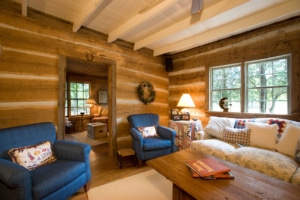
It was a place filled with memories of all the good times I’d had with the people I love. I came to realize that these emotional associations are the actual bricks and mortar of my experience of “home.”
It’s obvious if you think about it. A robin takes great care to build a nest and guards it jealously until her chicks have flown away. Then, that cherished nest is just another pile of sticks. We humans are not that much different.
A house is a material object. A “home” is of the heart.When people are looking for a new living space, they are really looking for how that new space “feels,” and how well it fits the day to day reality of their lives, and the values that are important to them.
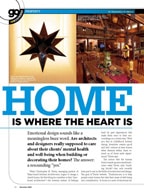
Now, years after I had that first realization, I am finally approaching my goal. The human mind is complex, and my skills and training are limited, but after years of research and working with clients, I have developed a systematic process that combined psychological testing and architectural programming in a way that actually identifies what specific features of a house inspire an individual or a family to “feel at home.”
But before I brag about my accomplishment, let’s consider a critical question.
What exactly is the advantage of knowing for yourself what features of a building or a location will inspire you to feel at home?
In his book, The Timeless Way of Building, Christopher Alexander says “The specific patterns out of which a building or a town is made may be alive or dead. To the extent they are alive, they let our inner forces loose, and set us free; but when they are dead they keep us locked in inner conflict.”
Mr. Alexander’s theory says that architecture gains aliveness by reflecting the patterns of behavior of those who inhabit it. In other words, the day to day repetitive actions, events and activities of human beings, naturally organize space in a way that is healing and nurturing.
When those patterns are ignored, he suggests, we have the type of architecture that now fills our cities…dead, mechanical boxes; impersonal and cold.

In our firm, we make it clear to our clients that a successful design is the result of a good partnership between the designer and the client. My partner and I may know a lot more about architecture and construction than our customers, but our clients are the experts on their own values, tastes, lifestyle and budget.
Time and again however, we find that clients approach us with a broad set of assumptions about cost and design, assumptions that are often poorly grounded in fact. These misconceptions tend to color their requests, often causing them to misrepresent their needs and desires.
In other words, people think they know what they want, but are often wrong about significant parts of it.
Over time we have found it important to serve as a “devil’s advocate” and challenge our clients’ preconceived ideas if we were to truly discover their most basic priorities. It soon became obvious to us that if we were sincere about trying to get at these deeper issues within our customers, and not just impose our own design ideas on them, we would have to take them on a journey of discovery.
Each person has a unique relationship with the aesthetics of space and form based on a number of factors, most of which are unconscious and purely emotional. If these items can be identified, and included in their design, they feel psychologically more at home in their new space.
The reason we believe this is that modern neuroscience has effectively proven it to be true. Here are some facts about how your brain works that illustrate what I am saying.
Modern Neuropsychology suggests that less than five per cent of human actions are determined by planned, conscious thought.
The remaining 95% of human behavior is strongly impacted by emotion, feeling (sensory and somatic), and other unconscious influences.
Decisions about homes are particularly vulnerable to these types of “irrational” decisions as homes serve an ancient and instinctive role in human life, one that has substantial unconscious cultural and instinctive underpinnings.
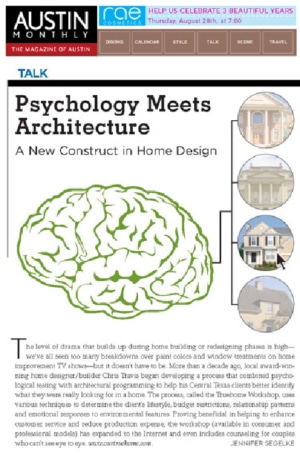
They are motivated by developmental or instinctive environmental cues in memory associated with past experiences. Those memories and instincts elicit neurotransmitter and/or hormone stimulated emotional response.
In other words, they make most of their decisions based largely on how they feel, while being reasonably certain they are making thoughtful, rational, conscious choices.
Evidence of this fact is that the home improvement industry in the U. S. is perennially the largest source of consumer complaints by industry sector.Real estate agents – despite their central role in the largest sector of the U. S. economy outside of government – are consistently rated amongst the “least trusted” professionals in the nation.According to a May 2006 Harris Poll survey, only 7% of those polled trust real estate agents completely, while 20% trust them not at all. Among 13 types of professionals, only stockbroker advice was trusted less than that of real estate agents.
The custom home building and home improvement sectors are enormously fragmented and inefficient given the vast scope of their activities. Building a single home typically involves as many a twenty or more distinct installation and service businesses – all with separate management, e
No other industry of that stature has escaped what is typically an inevitable centralization of providers in the marketplace, despite the obvious economic advantages involved.Most consumers now assume there is no holistic way to approach altering their living space and for the most part, they are right.
On the home front, interpersonal issues between co-habitants during the planning and construction of home improvement projects are so common as to reach the threshold of legendary.
Everyone on the street knows someone, or has heard of someone, who had a traumatic or at least highly-stressful experience with building or home improvement. Couples are often unaware of the impact that architectural issues have on small incompatibilities in their relationship.

After a while, I discovered they had an argument almost every day while preparing for work. However – the wife explained – their conflict had nothing to do with the sink. It was her husband’s fault. He always left his whiskers in the basin when he shaved!
Neither of them had been able to see that it is much easier to add a sink to a bath than to change the habits of a spouse! That may seem obvious, but I have found that such oversights are common.
Almost all of us find it hard to separate the forest from the trees when it comes to our immediate surroundings.
In this same vein, I had a customer who refused to design in appropriate storage because his wife would “stack things everywhere anyway.” That’s what’s called a “self-fulfilling prophecy.
All of this tumult, inefficiency and disorganization is caused in large part by a misunderstanding about the true nature of a home. A home is not a building. It is a suite of emotional experiences. The old saying “a house does not make a home” illustrates this reality. Intuitively, people are aware of this, but in general business practice, the fact is largely ignored.
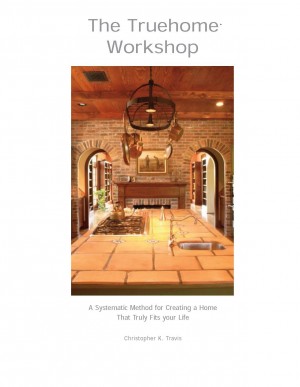
We are now able to predict for each individual and family, what features in the architecture, location and style of a house will actually produce for them the emotional experience of “home.”
That experience is close to the heart, inextricably intertwined with safety and comfort and family. Complicated emotions come into play when the issue of home is on the table. Decisions about the design and cost of our homes are often the single most significant financial choices of our lives.
The pressure is on when you take on a major project. The emotional fire is hot. Building and remodeling our homes can lead to considerable stress. But the story can have a happy ending. Sometimes dreams do come true…and dream homes.
In our hearts is a special place. Surrounded by the memories, special attachments and fond impressions that create our emotional architecture…is a warm and comfortable sanctuary just waiting to be discovered.
[/vc_column_text] [/vc_column] [/vc_row] [vc_row el_position=”last”] [vc_column width=”2/3″] [/vc_column] [vc_column width=”1/3″] [/vc_column] [/vc_row]
